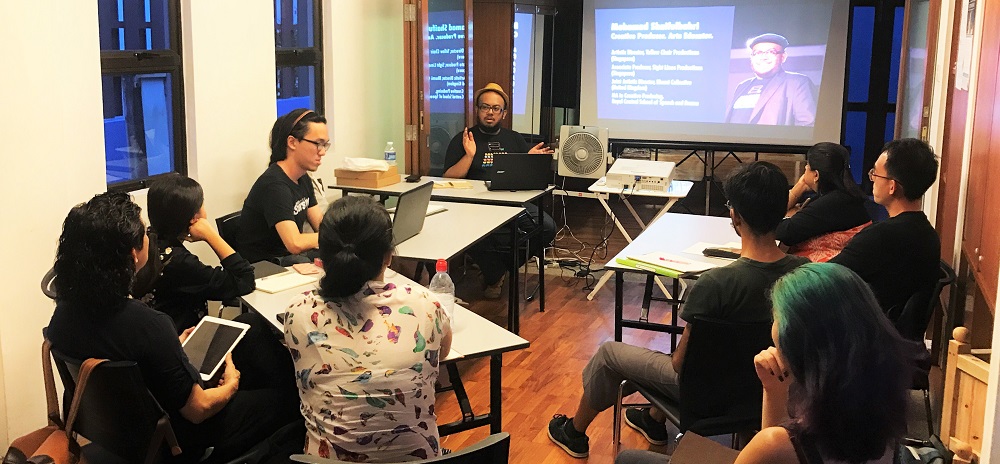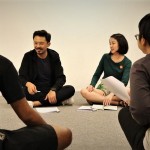
Shai conducted the first edition of his workshop, titled “Where do I Begin? Producing for the Stage”, at Centre 42 in March 2016. He’s bringing it back this January. Photo: Derrick Chew
Mohamad Shaifulbahri (aka Shai) didn’t use to call himself a producer. Best known as the former artistic director of Yellow Chair Productions – a community theatre group that he founded in 2005 at the age of 19 – he had previously only seen himself as a director.
His turning point came in 2015, when his friends pointed out that he had also been producing shows all along. 2015 also marked the 10th anniversary of his company, which he felt was a good time to reassess his role within it, as well as the direction that he wanted to take as a practitioner. After some soul searching, he made the decision to move to London to pursue a Masters in Creative Producing at the Royal Central School of Speech and Drama in September that year, to deepen his understanding of what it means to be a theatre producer.
“Choosing to study Creative Producing for my MA – and to really move into becoming a producer – was a risk, because I would be in the position where I am the one making sure the work happens. But I realised that that’s what I enjoy doing,” he says.
Moving to the UK opened many new doors for him. For instance, it allowed him to reconnect with his childhood friend Soultari Amin Farid, a choreographer who is currently a PhD candidate at Royal Holloway, University of London. Together, they formed a new company called Bhumi Collective, which made its debut with a production called bhumi at the Edinburgh Fringe Festival in 2016.
But even though Shai managed to secure a work visa to stay on in the UK after graduation, the urge to come home got stronger, and he moved back on his 32nd birthday in January this year.
“It made sense to come back. While we’re interested in doing transnational, multicultural work with Bhumi Collective, we felt that it’s better for us to build the company in one country first. Singapore is the better choice – firstly, Amin and I are both Singaporeans, and practically speaking, we’re more connected to the scene here, and we also have better access to funding,” Shai explains. “Personally, I am also interested in helping to grow and support the producing scene in Singapore.”
He notes that there have been several new initiatives aimed at supporting young producers coming up in recent years, such as the Creative Producers Development Programme (CPDP) by arts management and consulting agency CultureLink. Launched in 2015, it gives selected participants the opportunity to embark on an international residency and learn from industry veterans. A monthly meet-up series called the Producers’ Social was also formed by independent producer and past CPDP participant Pearlyn Cai and CultureLink’s producer Hoo Kuan Cien in 2017, for emerging and established producers to meet, talk, and share resources. The fifth edition of the event, titled “Producing Independent: Strategies, Tools, Gaps”, will be taking place at Centre 42 on 30 January.
But Shai also noticed that there are currently no arts schools in Singapore that offer a course in Producing.
“We’re at a point in time where people are very interested in creating their own work, and where actors also want to be performance makers,” he says. “But if they don’t have an opportunity to try doing producing without a safety net, a lot of them wouldn’t do it, because there is potential for considerable loss. So we want to create a platform for them to try producing while mitigating some of the risk.”
In the next few years, Shai hopes to create a programme – either in collaboration with an arts school, or independently – for emerging producers to learn the craft of the trade, and get hands-on experience by working with Bhumi Collective. For now, though, he has been testing out a smaller workshop series called “Where do I Begin? Producing for the Stage”. He held the first edition at Centre 42 when he visited Singapore last year, and will be bringing it back again from 29 January. Over the course of five sessions, he will be sharing insights into topics like how venues operate, budgeting, and marketing, while adapting the content to suit the needs and interests of the participants.
“I really enjoyed the process of sharing things like my email exchanges with sponsors and venues with the participants last time. The highlight for me was the budget building session, because at the end of it they realised how much it costs to put up a show, and gained a better understanding of what theatre companies go through,” says Shai. “I want to arm the next generation of producers with that knowledge and understanding.”
To Shai, a producer is many things. For starters, they are usually the first one to enter the project, and the last one to leave, as it is their job to close the accounts and settle all outstanding matters after the production team bumps out of the theatre.
“It’s tough to encapsulate what a producer does in a sentence sometimes, because if you go to my workshop, we have a whole section on the roles and responsibilities of a producer. You’ll realise that in the absence of particular roles within a production team – like a marketing person or a development officer – the responsibility often falls on to the producer,” he says.
He acknowledges that producers sometimes have a bad reputation for threatening the creativity of the artistic team, but firmly believes that that shouldn’t be the case.
“We are here to help and support the team,” he insists. “Good producers should know the role of each team member and be careful not to overstep the line. So I think it’d be good for more people to know about what producers do.”
By Gwen Pew
Published on 10 January 2018
“Where do I Begin? Producing for the Stage” will take place at Centre 42 from 29 January to 12 February 2018. Find out more about the workshop here, and register by emailing hello@bhumicollective.com.
For more information about the Producers’ Social, follow the Creative Producers SG Facebook page.





